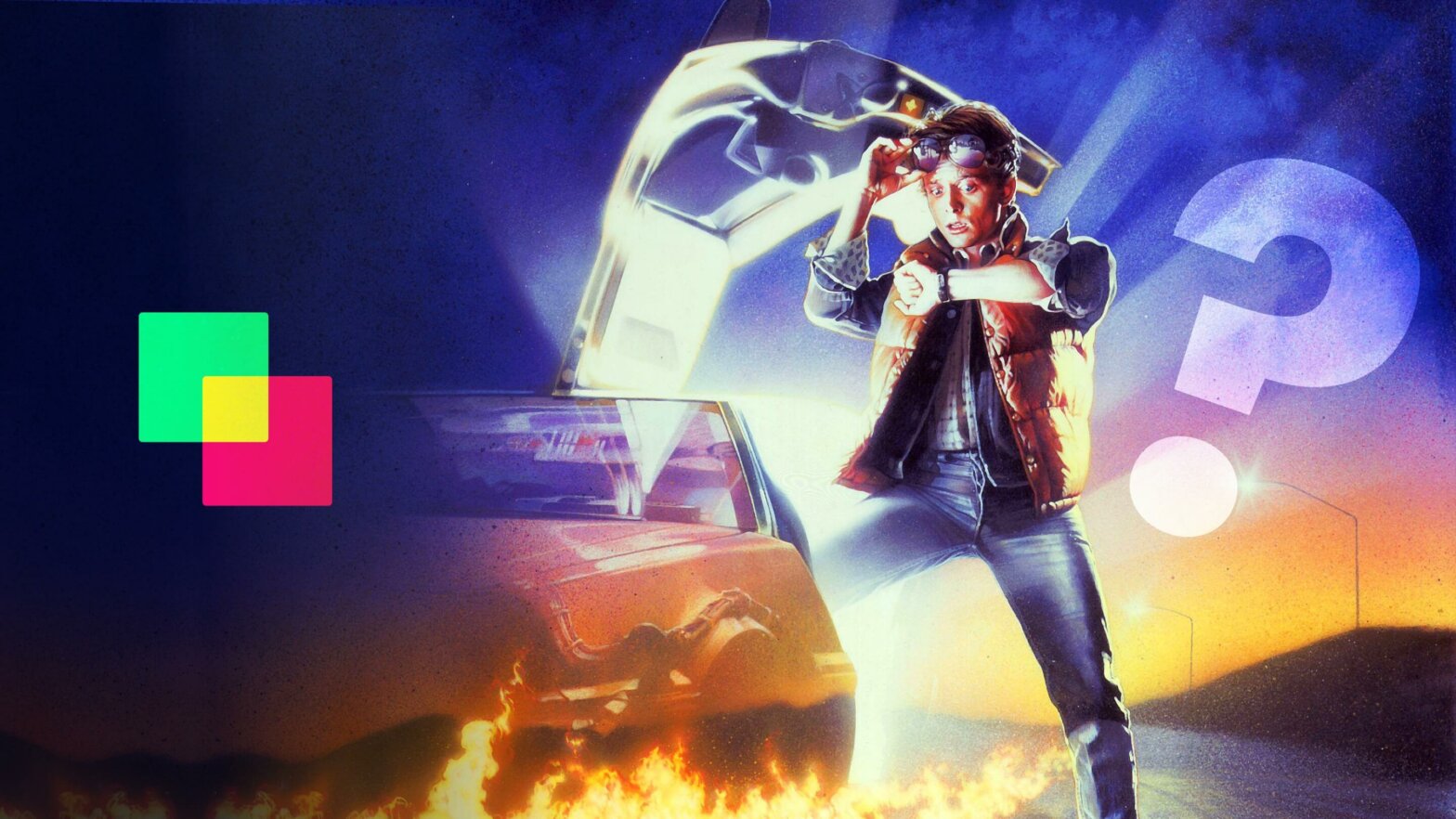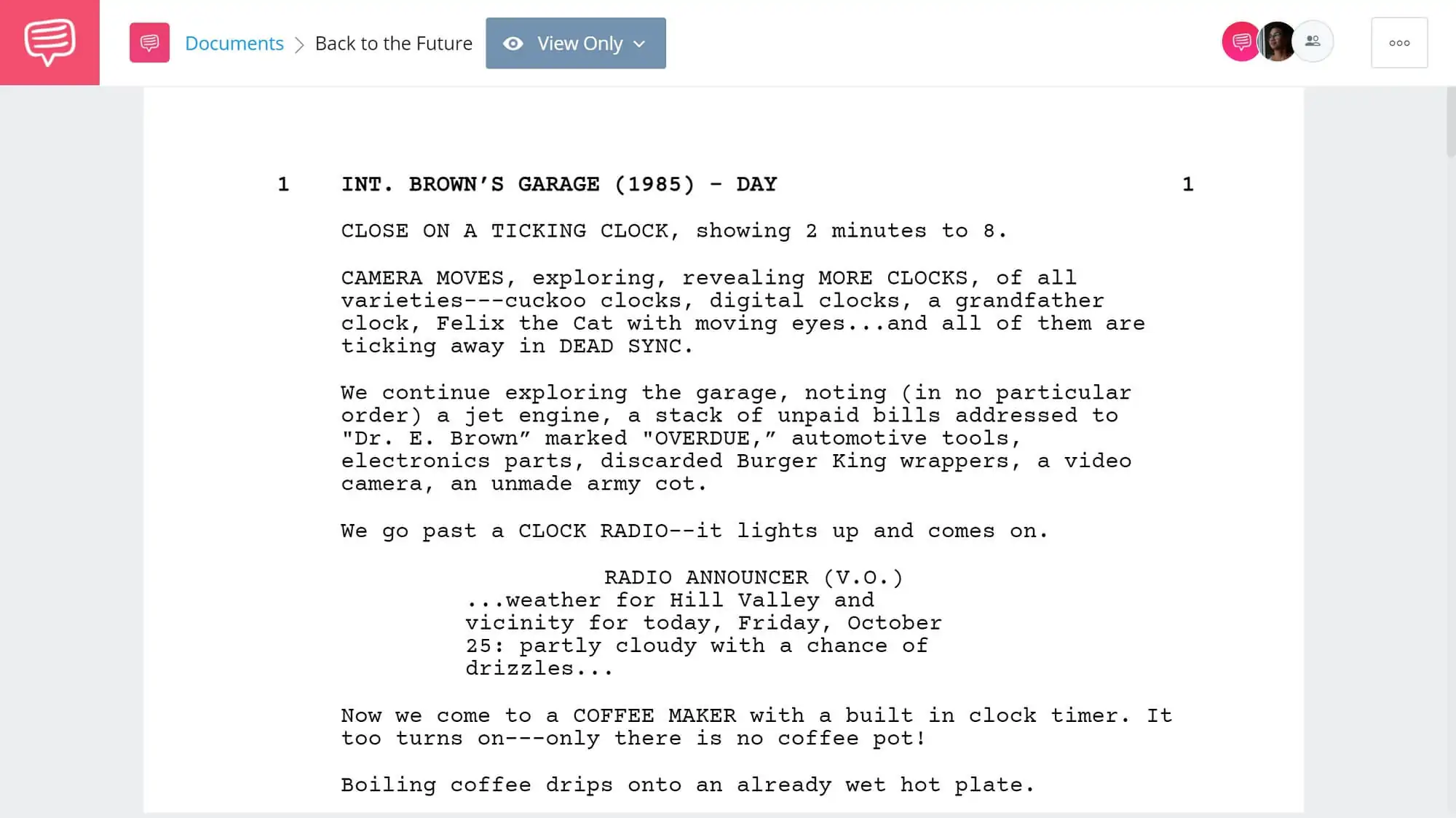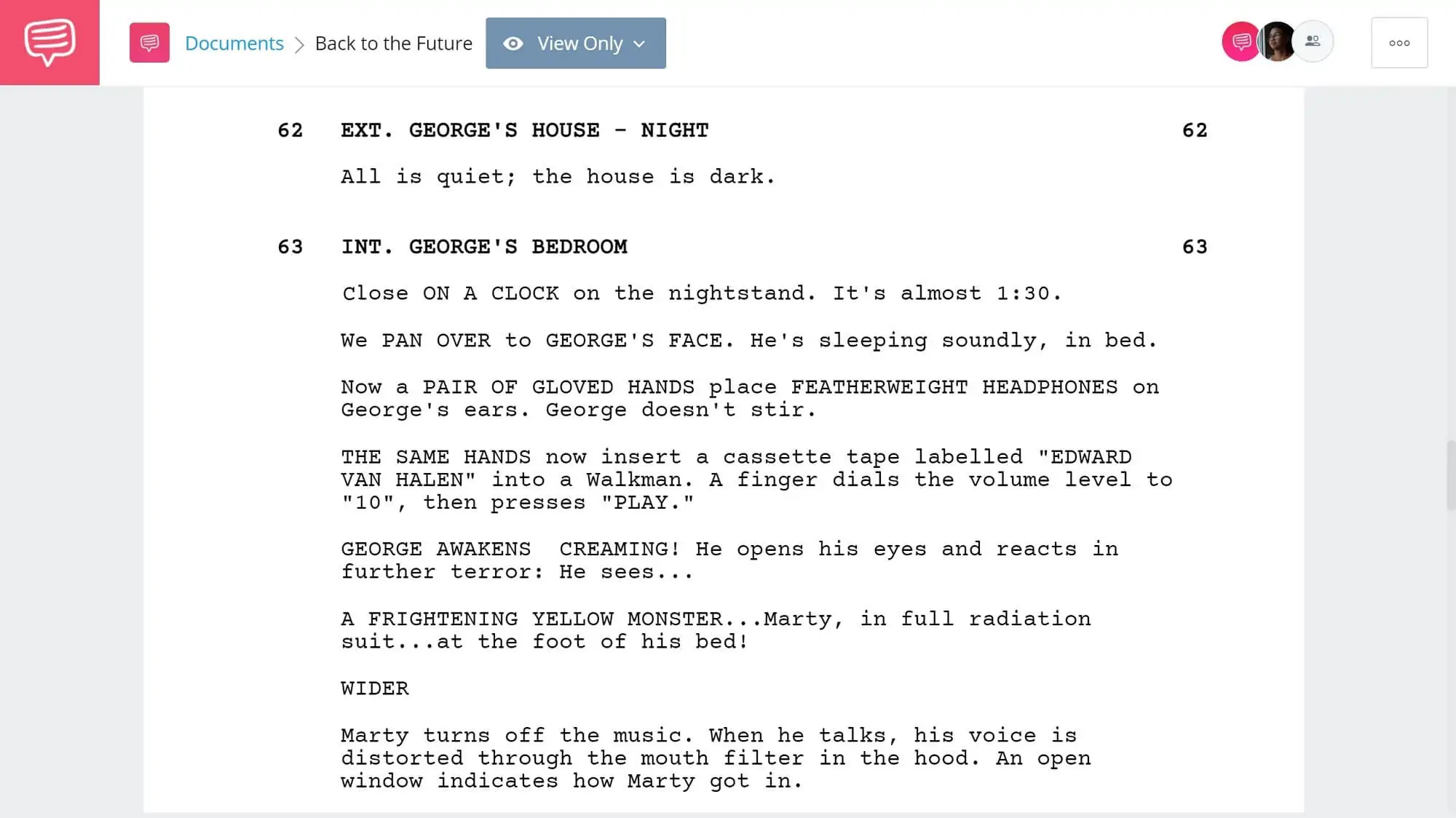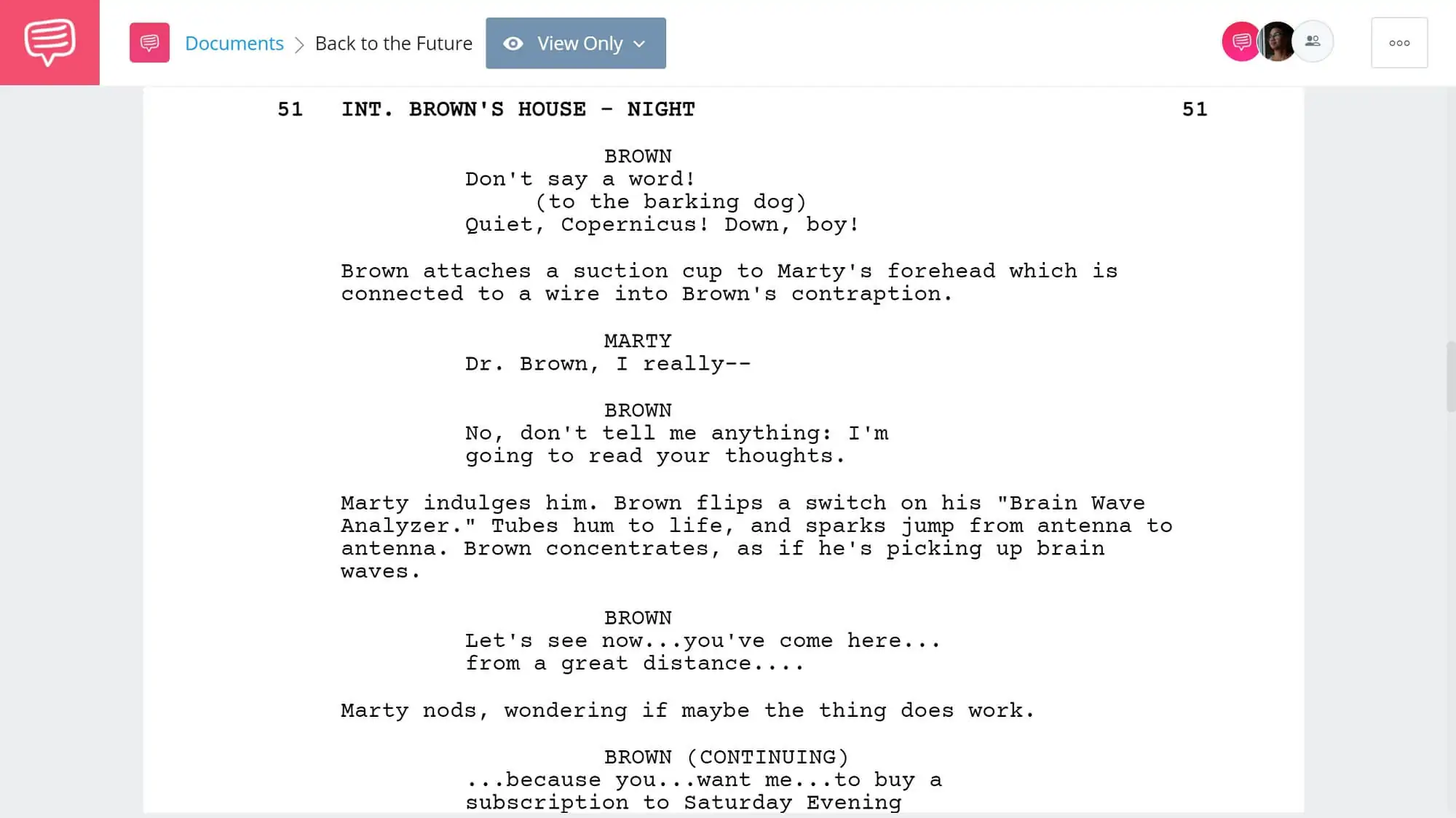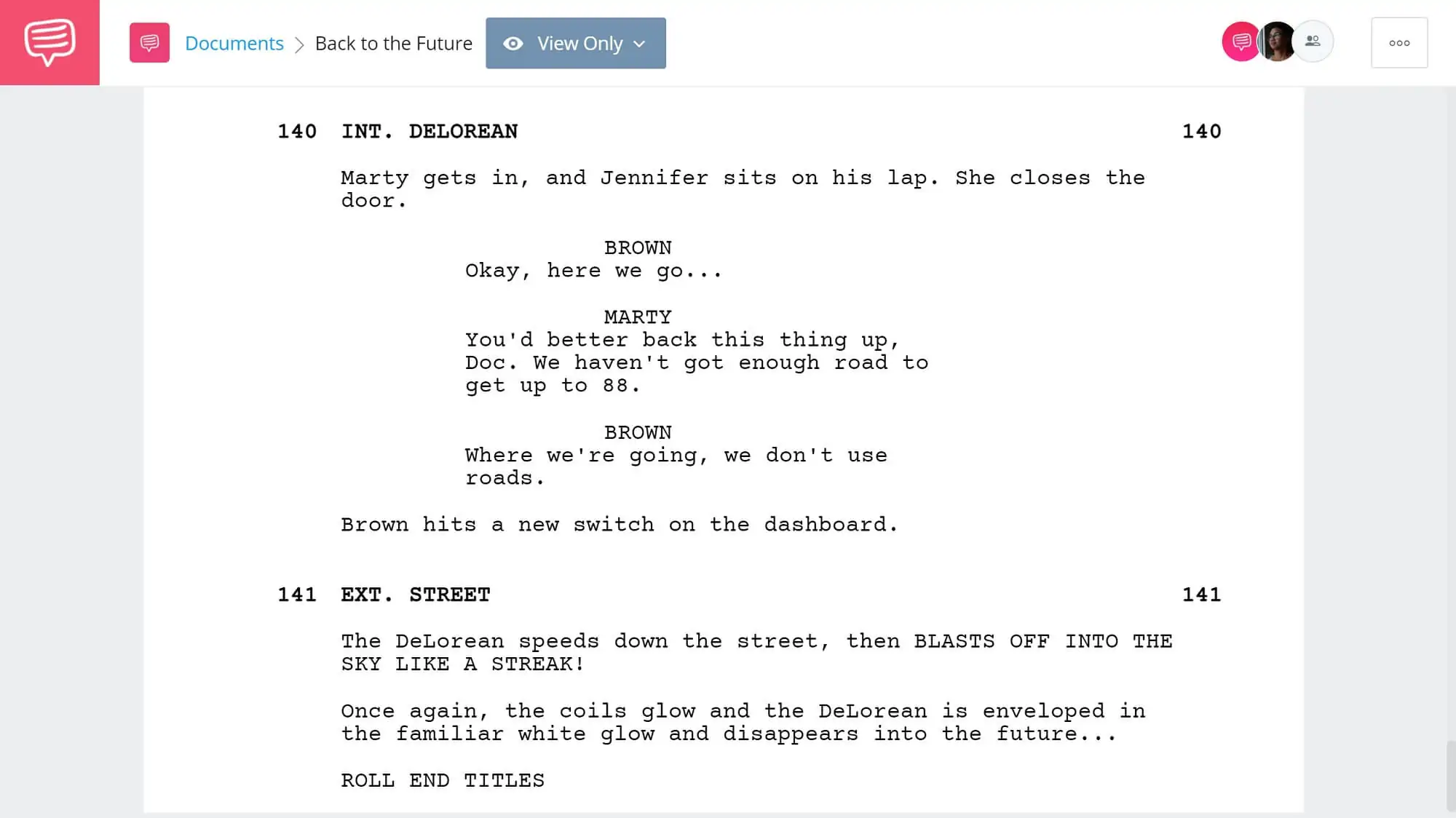Did you know that the Back to the Future script was nominated for Best Original Screenplay at the 1986 Academy Awards? Back to the Future may be most famous for its incredible production design and visual effects, but the script is excellent as well. We’re going to break down the Back to the Future screenplay by looking at its characters, quotes and iconic ending. By the end, you’ll know why the original Back to the Future script is such an iconic example of effective screenwriting. Doc, rev up the DeLorean, we’re going back – back to the future!


WHO WROTE back to the future SCRIPT?
Written by Robert Zemeckis and Bob Gale
Robert Zemeckis is an American writer, director and producer who has worked on a variety of critically acclaimed and commercially successful films. In 1995, Zemeckis won the Academy Award for Best Director for his work on Forrest Gump. Some of his other most iconic films include Back to the Future, Who Framed Roger Rabbit?, and Cast Away.
Bob Gale is an American writer, director and producer who is perhaps best known for his frequent collaborations with Zemeckis. On his own, Gale has directed movies like Interstate 60: Episodes of the Road and Mr. Payback: An Interactive Movie.
Script Teardown
STRUCTURE OF THE BACK TO THE FUTURE SCREENPLAY
Here is the Back to the Future summary:
Exposition
Marty McFly is a 17-year-old high school student with a girlfriend named Jennifer and a bad reputation with teachers. Marty spends a lot of time with “Doc,” a mad scientist who has a reputation for being eccentric.
Inciting Incident
Doc shows Marty his custom time machine – modeled out of a DeLorean steel car – and retrofitted with a flux capacitor that runs on plutonium, which Doc recently stole from Libyan terrorists wanting him to make a bomb. The Libyans shoot Doc in retaliation, forcing Marty to escape in the DeLorean — which sends him back in time.
Plot Point One
Marty accidentally travels 30 years into the past, exhausting the DeLorean’s entire supply of plutonium. Before Marty’s able to reach Doc, he finds his father “peeping” on his mother. Marty’s then hit by his grandfather’s car (instead of his father who he pushes out of the way) and has an awkward scene with his mother.
Rising Action
Marty finds Doc and shows him the time machine. Convinced that Marty is telling the truth, Doc hatches a plan to use a massive jolt of electricity rather than plutonium to jump start the vehicle. However, the “clocktower” lightning bolt is a week away, which means that Marty’s stuck in 1955.
Midpoint
Doc realizes that Marty has interfered with “the timeline,” and that if he can’t get his parents together, he’ll never be born. Marty introduces George (his father) to Lorraine (his mother) – but instead of falling for George, Lorraine falls for Marty.
Plot Point Two
After a series of failures, Marty unites George and Lorraine. The couple kisses on the dance floor, guaranteeing that Marty will one day be born.
Build Up
Doc and Marty prepare the time machine to send him back to the present. Marty attempts to warn Doc that he’s going to be shot in 1985, but Doc refuses to hear it – saying that any further knowledge of the future could alter the timeline. Marty leaves a warning note for Doc.
Climax
Marty configures the settings on the time machine to go back just a few minutes before Doc is shot. The DeLorean reaches 88 mph just as lightning strikes the clocktower, powering it through time back to 1985.
Finale
Marty arrives a second too late and Doc is shot again. However, Doc reveals that he read Marty’s warning letter and wore protective armor.
Denouement
Marty wakes up the next morning to discover his family is happier than ever before – and that George and Lorraine are still madly in love. But then Doc arrives in the DeLorean and tells him that he and Jennifer need to come “back to the future” for an important mission.
Back to the Future Script Analysis #1
Back to the Future quotes are dramatic
There are a lot of great elements to the Back to the Future screenplay, but perhaps none are more iconic than the film’s quotes. Some of the Back to the Future quotes are among the best quotes of all-time.
We imported the Back to the Future original script into StudioBinder’s screenwriting software to take a closer look at some of the best Back to the Future quotes. In this scene, we’ll see how writers Robert Zemeckis and Bob Gale use dramatic irony for comedic effect – en route to creating some great quotes along the way.
Dramatic irony is when the audience is privy to more information than some characters are. Since Back to the Future is about a character who goes back in time, we the audience, along with Marty McFly, are privy to more information than everybody in Hill Valley in 1955.
Back to the Future uses dramatic irony for comedic effect – like when Marty is forced into an incestuous situation with his mother. Wait maybe that’s not that funny – but it definitely was intended to be. Perhaps the best use of dramatic irony in Back to the Future comes when George is visited by “an alien” who’s really just Marty in disguise.
Script Back to the Future • Read the ‘Darth Vader’ Scene
Zemeckis and Gale use pop culture jokes to bridge the gap between past and present – best exemplified by the quote “This is no dream! You are having a Close Encounter of the Third Kind. You have reached The Outer Limits of The Twilight Zone.” Boom. That’s how you integrate three pop culture references at once!
Let’s look at a clip from the movie to see how this scene came together.
Back to the Future Analysis • Script Back to the Future in Action
First and foremost, this scene is a lot of fun. Back to the Future is a popcorn-thriller, so the primary focus is on keeping the plot moving at a brisk pace. But the use of dramatic irony makes this scene more than just a disposable part of the plot – it makes it an all-time cinema classic.
Here are some of the other best Back to the Future quotes:
- "Hello? Hello? Anybody home? Huh? Think, McFly, think!"
- “Why don’t you make like a tree and get outta’ here?”
- "When this thing hits 88mph, you're gonna see some serious shit."
- “You built a time machine...out of a DeLorean?!”
- “Who's President of the United States in 1985?" "Ronald Reagan." "Ronald Reagan?! The actor?! Ha! Who’s the Vice President? Jerry Lewis?”
- "Great Scott!"
- "1.21 gigawatts!"
- "Last night, Darth Vader came down from Planet Vulcan and told me that if I didn't take Lorraine out, that he'd melt my brain."
- “I guess you guys aren’t ready for that yet. But your kids are gonna’ love it.”
- "Roads? Where we're going, we don't need...roads."
Back to the Future Script Analysis #2
Back to the Future characters work
The Back to the Future franchise succeeds on the back of the relationship between Doc and Marty McFly. Zemeckis and Gale do an excellent job of building the relationship between these two characters in the first film – and perhaps better than anything, they do an excellent job of showing how Marty is the protagonist and how Doc is his primary support.
In screenwriting, it’s of the utmost importance that characters serve “narrative roles” – such as antagonist, support, etc. That doesn’t mean the roles of characters can’t change; quite the contrary actually. Oftentimes, it’s great for a story when the role of a character changes. But if one thing’s for certain, it’s that every story needs a protagonist and a supporting character.
In this next scene, we’ll see why Marty and Doc have such a perfectly symbiotic relationship. As you’re reading, think about which character is the central focus of the scene and which character is more supplemental to it.
Back to the Future Characters • Read the ‘Doc and Marty’ Plan Scene
Doc has a penchant for dominating scenes because of his exuberant personality, but in a plot sense, he tends to be more supporting than leading. We see this type of relationship a lot in screenwriting – one where the protagonist is rather flat compared to the eccentricity of a supporting character.
When this is done well, it can take a lot of pressure off the protagonist. Perhaps it’s helpful to think about this type of relationship as “the protagonist as the outline and the supporting character as the color that fills it in.”
Back to the Future characters “double down” on this idea with expressive mise en scene. Let’s look at the scene from the film to see how costumes, hair and makeup, and props reinforce Doc’s eccentricity.Back to the Future Characters • ‘Doc and Marty’ Clip
We can learn a lot about screenwriting from the relationship between Doc and Marty. If applicable, consider framing the relationship between your protagonist and a supporting character just like these Back to the Future characters.
Back to the Future Script Analysis #3
The Back to the Future ending is open
Want to learn how to set-up a sequel? Just look to the ending of Back to the Future – well, perhaps don’t look to Back to the Future out of context. According to Robert Zemeckis, a sequel wasn’t planned for Back to the Future prior to its box-office success. So, why does the ending seem to set-up a sequel?
Let’s look to the Back to the Future ending to see how Zemeckis and Gale wrote an immensely satisfying ending while still leaving plenty of room open for a sequel. Pay attention to how the writers use the denouement to punctuate the theme of boundless possibilities. As Doc says, “Where we’re going, we don’t need...roads.”
Back to the Future Screenplay • Read the Back to the Future Final Script Scene
One of the best aspects of the Back to the Future ending is how it keeps its options open. You’re left to think, “is there going to be a sequel? Or is the point that there isn’t going to be a sequel?” Typically, this might be viewed as somewhat of a “cop-out” because endings are supposed to have narrative clarity. But as we alluded to earlier, an open-ended conclusion makes sense in the case of Back to the Future because of the “infinite possibilities” spirit of the story.
Let’s look at the clip from the movie. Keep the script open and check Doc’s outfit in the script against his outfit in the final cut.
Back to the Future Final Scene
Here’s a perfect example of a scene in which a piece of the production design was scrapped. Why? Probably because it was too difficult to dress Christopher Lloyd up in “a strange variation of a Roman tunic, a cape, and striped plastic pants” – with “a baseball cap that’s embroidered with the logo ‘Peoira World’s Fair 2015,’ and an American flag shoulder patch with 63 stars.”
It’s never a bad idea to give the characters in your script expressive outfits – just be mindful that if they’re too crazy, they might not be worth the trouble. Hopefully our Back to the Future analysis has been insightful! Just remember: be bold, be purposeful, and be expressive and you’ll never regret trying!
UP NEXT
Read and download more scripts
The Back to the Future movie script is proof that science-fiction movies don’t have to be somber and contemplative – they can also be fun and adventurous. If you want to continue reading screenplays, we have similar titles like Guardians of the Galaxy Vol. 2, Jurassic Park, and The Matrix in our screenplay database. Browse and download PDFs for all of our scripts as you read, write and practice your craft to become the next great screenwriter.
